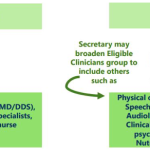 As I get older, I find the days on the calendar move by faster, even though I am certain the earth still spins at the same speed it did last year. Reminds me of the lyrics from that classic Pink Floyd tune, “Time”: “So you run and you run to catch up with the sun but it’s sinking, racing around to come up behind you again. The sun is the same in a relative way but you’re older.”
As I get older, I find the days on the calendar move by faster, even though I am certain the earth still spins at the same speed it did last year. Reminds me of the lyrics from that classic Pink Floyd tune, “Time”: “So you run and you run to catch up with the sun but it’s sinking, racing around to come up behind you again. The sun is the same in a relative way but you’re older.”
Memorial Day is the 5th and final Monday in the month of May, and coincidentally, each of the preceding May Mondays have seen the Acumen blog focus on MACRA. Should we make it 5 for 5? Given the fact that MACRA easily represents the most important change to physician reimbursement this generation has seen, my vote is yes.
This month we’ve unpacked several important features buried in the 962-page NPRM. Today let’s awaken the sleeping giant—quality. The impact quality has upon your paycheck is about to change in a very big way.
Recap
For those of you who have been stranded on a desert island for the past few weeks, the MACRA implementation proposed rule does a number of things. Chief among them is the creation of two classes of providers, those who will enjoy the advantages of an advanced alternative payment model (APM) and the majority of us who will face the tyranny of MIPS. MIPS (aka the Merit-based Incentive Payment System) is a program that applies a score from 0-100 to every provider across the land. Think of this as your test score (and there is no curve). That score is made up of contributions from 4 distinct sources:
- Quality, the topic of today’s post
- Meaningful use, masquerading as “advancing care information,” which Diana covered masterfully in week one
- Resource use, which will be a slice of the physician value based payment modifier
And, last but not least, the new kid on the block…
- Clinical practice improvement activities
At the end of the day, for the providers exposed to MIPS (which will be the vast majority of the docs in practice next year), your MIPS score determines what percentage of the 2019 physician fee schedule you will collect. When will your first MIPS score be calculated? That score will likely emerge in early 2018, but importantly, it will be based entirely on your activities during calendar year 2017.
P4R becomes P4P
As we dive into the quality piece of the MIPS puzzle, let’s start with the biggest change. While all around us, other providers in the health care space like hospitals and dialysis facilities have been exposed to CMS-based pay-for-performance programs, one can argue that as physicians we have been shielded from this aspect of the health care transformation that’s underway. One needs look no further than the existing meaningful use program or the PQRS program to recognize physicians are being paid to report quality. Actually, we are avoiding penalties these days, but the point is the only requirement to avoid the penalty is accurate reporting of the quality metric—how you actually perform has no impact on whether you are penalized or not. The one exception is the remarkably difficult-to-understand physician value based payment modifier (VM). Buried beneath layers of complexity, the VM does in fact surface a modicum of exposure to pay for performance. But let’s face it, the exposure is trivial.
Fast forward to January 1, 2017, (a mere 215 days from today for those of you keeping track at home). On that date the performance period for MIPS begins. The quality piece of MIPS is not a pay-for-reporting program. As an individual physician or as a practice, your performance as measured by 6 self-selected quality measures will be compared with the performance of all of the physicians around the country. Knock it out of the park and your MIPS composite performance score is favorably impacted (as is your Part B physician fee schedule in 2019). Stub your toe on performance and you may well be paid less than your neighbor in 2019. Can you hear the boys from Pink Floyd… “no one told you when to run, you missed the starting gun.”
50%!
As if the sudden change from P4R to P4P was not enough, the NPRM is suggesting the quality component of MIPS represent 50% of the provider or practice’s composite performance score for the MIPS payment adjustment in 2019. In other words, how you perform on those 6 quality measures next year accounts for half of your test score. Think about this for a moment. We have lived in a pay-for-reporting world for the past decade. Almost overnight, MACRA will turn quality reporting on its head.
This is not a PQRS Measures Group
The last impactful change? With MIPS, CMS has substantially expanded the breadth of quality reporting. Recall the PQRS CKD measures group many of you have reported over the past several years? Answer a few questions about 20 CKD patients and you clear the bar for PQRS reporting and avoid the penalty. With MIPS, you are not so lucky. As you select your 6 measures, be cognizant of the fact that a) you are now being paid based on your performance across the breadth of these measures, and b) depending on how you get the data to CMS, you must report on between 80-90% of your denominator-eligible patients for each measure during the performance year (2017).
Perhaps most disappointing to those of us within the nephrology arena, buried in the appendix of the NPRM is table E which highlights 23 groups of specialty-specific quality measures, many with the same denominator. Missing from this table? You guessed it—nephrology. Each of your practices will likely choose from the laundry list of general internal medicine measures, and recall your performance will be compared with every provider in the country who reports that quality measure.
Time
So what should you do? “Fritter and waste the hours in an offhand way” is not the answer I was looking for, but that song just won’t stop playing. First, make sure you understand whether or not you or your practice is participating in an alternative payment model (APM). If you are, there is a very good chance your quality score will be dictated by the quality score that APM records, so make sure you joined a good one! Second, if you are not in an APM, familiarize yourself with the proposed quality measures. Make sure you understand what your practice’s strengths are, and when the time comes, make your quality measure choices accordingly. Third, consider how you will report this data to CMS. Will it be through claims? Through your EHR? Through a QCDR like the one offered by the RPA?
Can you still hear the fellows from Pink Floyd? “Every year is getting shorter, never seem to find the time. Plans that either come to naught or half a page of scribbled lines.” The runway for making these decisions will be short if you wait around for the publication of the final rule, as we are unlikely to see the final rule until the fall of this year. Now is the time to give this some thought and put together a plan—half a page of scribbled lines is not going to cut it.
“You are young and life is long and there is time to kill today” resonated with me when The Dark Side of the Moon was released in the early 70’s. I am older now and would like to believe that collectively we are all a little wiser today. What are your thoughts about MACRA and its impact on quality reporting? Drop us a comment and join the conversation.
 Terry Ketchersid, MD, MBA, practiced nephrology for 15 years before spending the past seven years at Acumen focused on the Health IT needs of nephrologists. He currently holds the position of Chief Medical Officer for the Integrated Care Group at Fresenius Medical Care North America where he leverages his passion for Health IT to problem solve the coordination of care for the complex patient population served by the enterprise.
Terry Ketchersid, MD, MBA, practiced nephrology for 15 years before spending the past seven years at Acumen focused on the Health IT needs of nephrologists. He currently holds the position of Chief Medical Officer for the Integrated Care Group at Fresenius Medical Care North America where he leverages his passion for Health IT to problem solve the coordination of care for the complex patient population served by the enterprise.




Joe brannigan says
Great overveiw,love the Pink Floyd lines.MIPS is one of the few things in life that is more frightening than time.